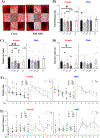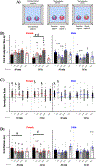Sex-specific effects of perinatal FireMaster® 550 (FM 550) exposure on socioemotional behavior in prairie voles
- PMID: 31730801
- PMCID: PMC7214199
- DOI: 10.1016/j.ntt.2019.106840
Sex-specific effects of perinatal FireMaster® 550 (FM 550) exposure on socioemotional behavior in prairie voles
Abstract
The rapidly rising incidence of neurodevelopmental disorders with social deficits is raising concern that developmental exposure to environmental contaminants may be contributory. Firemaster 550 (FM 550) is one of the most prevalent flame-retardant (FR) mixtures used in foam-based furniture and baby products and contains both brominated and organophosphate components. We and others have published evidence of developmental neurotoxicity and sex specific effects of FM 550 on anxiety-like and exploratory behaviors. Using a prosocial animal model, we investigated the impact of perinatal FM 550 exposure on a range of socioemotional behaviors including anxiety, attachment, and memory. Virtually unknown to toxicologists, but widely used in the behavioral neurosciences, the prairie vole (Microtus ochrogaster) is a uniquely valuable model organism for examining environmental factors on sociality because this species is spontaneously prosocial, biparental, and displays attachment behaviors including pair bonding. Dams were exposed to 0, 500, 1000, or 2000 μg of FM 550 via subcutaneous (sc) injections throughout gestation, and pups were directly exposed beginning the day after birth until weaning. Adult offspring of both sexes were then subjected to multiple tasks including open field, novel object recognition, and partner preference. Effects were dose responsive and sex-specific, with females more greatly affected. Exposure-related outcomes in females included elevated anxiety, decreased social interaction, decreased exploratory motivation, and aversion to novelty. Exposed males also had social deficits, with males in all three dose groups failing to show a partner preference. Our studies demonstrate the utility of the prairie vole for investigating the impact of chemical exposures on social behavior and support the hypothesis that developmental FR exposure impacts the social brain. Future studies will probe the possible mechanisms by which these effects arise.
Keywords: Anxiety; Brain; Endocrine disrupting chemicals; Endocrine disruptors; Flame retardants; Neural; Neurodevelopment; Social.
Copyright © 2019 Elsevier Inc. All rights reserved.
Conflict of interest statement
Declaration of competing interest The authors declare that they have no known competing financial interests or personal relationships that could have appeared to influence the work reported in this paper.
Figures







References
-
- Aitken AR, Törk I, 1988. Early development of serotonin-containing neurons and pathways as seen in wholemount preparations of the fetal rat brain. Journal of Comparative Neurology 274(1), 32–47. - PubMed
-
- Anderson GM, Freedman DX, Cohen DJ, Volkmar FR, Hoder EL, McPhedran P, Minderaa RB, Hansen CR, Young JG, 1987. Whole Blood Serotonin in Autistic And Normal Subjects. Journal of Child Psychology and Psychiatry 28(6), 885–900. - PubMed
Publication types
MeSH terms
Substances
Grants and funding
LinkOut - more resources
Full Text Sources

